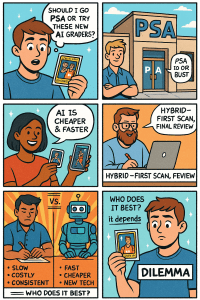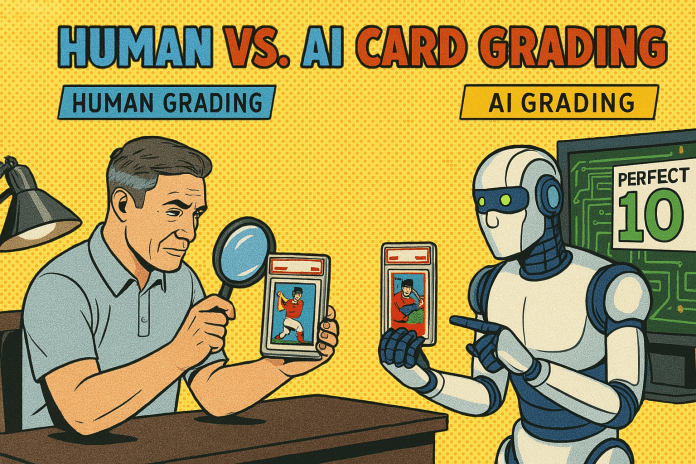If you’ve ever stared at a minty-fresh rookie card and wondered, “Should I send this to PSA or try one of those new AI grading apps?”—you’re not alone. The card grading world is evolving fast, and collectors are caught between tradition and tech. So let’s break it down.
PSA plans to own the market. Not just dominate it. They intend to have no competition that they don’t also own. Eventually, it needs to be regulated. SGC is still my fave but with collectors largely sucking at PSA’s teet, the SGC market is dwindling. Becket? I’m not sure.
Why wouldn’t people want AI grading?
🤔 What Is Card Grading, Really?
Card grading is a crucial evaluation process that determines the condition of a sports card, significantly influencing its value and appeal to collectors.—centering, corners, edges, surface—and assigning it a score, usually on a 1–10 scale. That score affects everything: value, marketability, and bragging rights.
Traditionally, grading has been done by trained professionals at companies like PSA, BGS, and SGC. However, now AI-powered platforms are entering the game, promising faster turnaround times, lower costs, and “objective” results.

🧠 Human Grading: The Legacy Standard
Human graders bring experience, nuance, and a collector’s eye to the table. They can spot subtle print defects, understand vintage quirks, and factor in context—like how a 1986 Fleer Jordan might be held to different standards than a 2023 Topps Chrome rookie.
Pros:
- Trusted by the hobby for decades
- Backed by brand reputation (PSA, BGS, etc.)
- Can interpret context and card history
Cons:
- Subjective—two graders might score the same card differently
- Long turnaround times
- Higher cost per submission
Want to dive deeper into grading standards? Check out our article on “How PSA Grading Works” for a behind-the-scenes look.
🤖 AI Grading: The New Frontier
AI grading uses computer vision and machine learning to scan your card and assign a score based on pixel-perfect measurements. Companies like Arena Club, TAG, and others are pushing this tech forward.
Pros:
- Fast and affordable
- Consistent scoring (no human bias)
- Often includes digital reports and 3D scans
Cons:
- Still gaining trust in the hobby
- May miss context (e.g., print variations, vintage quirks)
- Limited resale value compared to PSA/BGS slabs
There’s no need for trust issues. AI grading should be loved by all. AI graders don’t get sick, they don’t call in, they don’t have bad moods, they don’t have bad eyes, they’re not color blind, they’re not maniacs. AI graders save everyone money and time.
Curious how AI grading stacks up in real-world sales? We break it down in “Do AI-Graded Cards Sell for Less?”

🔍 Side-by-Side Comparison
| Feature | Human Grading | AI Grading |
|---|---|---|
| Speed | Slow (weeks/months) | Fast (hours/days) |
| Cost | Higher | Lower |
| Consistency | Variable | High |
| Market Trust | Strong | Growing |
| Resale Value | Higher | Lower (for now) |
| Context Awareness | High | Limited |
💬 What Collectors Are Saying
Some collectors swear by the legacy slabs—“PSA 10 or bust.” Others are embracing AI for quick flips and personal collections. The truth? It depends on your goals.
If you’re grading for resale, human grading still rules. But it shouldn’t. It’s only us collectors that set that precedent. There is NOTHING a human grader does better than an AI grader.
But if you’re building a PC or want fast, affordable insights, AI might be your new best friend.
🧩 Hybrid Approaches: Can They Coexist?
Some platforms now offer hybrid grading—AI does the initial scan, and a human reviews the final score. This could be the sweet spot for collectors who want speed and trust.
We explore this trend in “The Rise of Hybrid Card Grading,” including interviews with startup founders and longtime graders.
🏁 Final Thoughts: What’s Right for You?
There’s no one-size-fits-all answer. If you’re chasing top-dollar sales, stick with PSA or BGS. If you’re experimenting, building a PC, or just want to know your card’s condition fast, AI grading is worth a look.
And if you’re still unsure, start with our “Beginner’s Guide to Card Grading”—it’ll walk you through the basics and help you choose your path.



